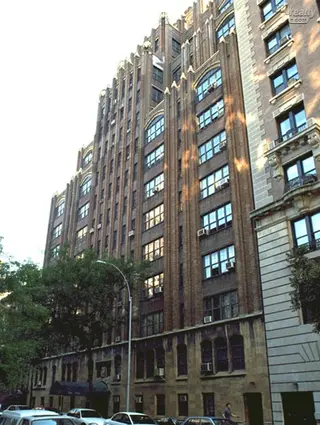 Carter Horsley
Carter HorsleyDec 23, 2011
Carter's Review
This distinguished, 14-story, mid-block, apartment building at 160 West 73rd Street was completed in 1929 as Sherman Square Studios for Walter Russell.
A May 27, 1928 article in The New York Times maintained that the building was "another in a long series of studio buildings erected by Walter Russell since 1900, at which time he began the erection of the studio colony on West 67th Street, and later on his east side studio buildings and Pierre s at 290 Park Avenue." The West 67th Street "colony" included the celebrated Hotel des Artistes, known for its very large painter's studios and its ground-floor restaurant.
"A notable feature of this building," the article continued, "is the fact that it will be scientifically sound-proofed, even to the doors. The walls dividing each studio are not only double walls, but the building has been so planned that the studios are separated from each other by intervening chambers, and from the corridors by waiting rooms, pantries, bathrooms etc. In these days of radio, the sound-proof feature should be an interesting feature of all classes of buildings, and the innovation of sound-proofing on this building may be an object lesson worth emulating."
The article also noted that the building was to have "free cooking service in a main kitchen, where the cooks' wages are part of the operating expenses of the building and where the tenants' food may be prepared for them and sent to their rooms in heated containers."
"Another special innovation of this building," it maintained, "is an electrical signal service between a general secretarial room on the ground floor and each apartment. This feature will be especially valuable for teachers of music and painters who do not wish to be disturbed in their work, but whose business messages will be attended to by the general secretary."
Tillion & Tillion were the architects also of The Opera Building at 2162-2168 Broadway.
The very handsome "neo-Gothic-style" building has a two-story stone base with a canopied entrance and large multi-paned windows, piers topped by finials, setbacks and protruding air-conditioners. There are arched "eyebrow" architectural elements over the windows on the 9th floor.
The building, which is close to Verdi Square and an express subway station, has 148 apartments.
Sam Baron of the New York Woodwind Quintet recalled that it performed a concert in Blue Hill, Maine, at which Samuel Barber, the composer, asked if he could listen them rehearse. He subsequently developed a work called "Summer Music" based in part on some selections the quartet played for him.
"On March 21, 1956, Barber threw a little party in New York at the Sherman Square Studios on West 73 St. He asked us to play Summer Music at this party. As a matter of fact we played it twice. Present at this gathering were composers and other musicians. I remember Gian Carlo Menotti and Walter Trampler. Barber explained to the guests that this was his most recent piece, and that it was going to the publisher. Because of its unusual form he would value comments and observations by the assembled musicians and music lovers. Did it work? Was it effective? We played it and then there were drinks and appetizers. Many people had comments, but I think that Barber had his mind made up. There were some cuts that he made in the piece but no real changes of any of the musical material. One criticism that I heard that day was, 'Sam, your ending is not effective. And besides you do the same ending twice.' I don't think this bothered him in the least," adding that it probably became the "most performed woodwind quintet of the entire repertoire."
Mr. Russell, who was also a painter and a philosopher, later would buy Swannonoa on Ashton Mountain in Virginia, an impressive mansion that was modeled after the Villa Medici in Italy.
The United States Navy considered purchasing the property in 1942 to establish a secret facility to interrogate prisoners of war but eventually rejected it in favor of a Civilian Conservation Corps camp in Fort Hunt, Virginia, code named P. O. Box 1142, because it seemed unlikely that Congress would approve the purchase of such a palatial structure for the purpose. The house remained empty during the war and was finally leased in 1949 to Walter Russell for his University of Science and Philosophy. He died in 1962 and his wife, Lao, died in 1988, and the university gave up its lease in 1998.

- Rental built in 1929
- 3 apartments currently for rent ($3.4K to $3.8K)
- Located in Broadway Corridor
- 148 total apartments 148 total apartments
 6sqft delivers the latest on real estate, architecture, and design, straight from New York City.
6sqft delivers the latest on real estate, architecture, and design, straight from New York City.
